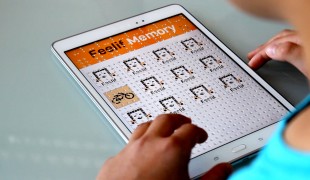- 8129
- 526
- 6
- 11
- 3
- Help Ukraine
About the solution
Williams Syndrome is a rare genetic disease that is characterised by mild to moderate intellectual disability or learning problems, unique personality characteristics, distinctive facial features, and heart and blood vessel (cardiovascular) problems.
Craig’s daughter, Imogen, was born with Williams Syndrome, compromising her learning skills and concentration. Craig realised that using a virtual reality (VR) headset was a big help for his daughter.
“I noticed how well she adapted to it... So I knew she’d like to see more.”, Craig said.
Craig did not stop there. He started working on his own VR experience and created a set of videos with different themes, each lasting around four to six minutes. He created videos on diving under water, space and stars observation and visiting animals. As loud noises are stress factors for Imogen all the videos are complemented with calm music, animal sounds and more. This experience helped Imogen to relax and also to stimulate her brain activity.
“The scene was magical to witness,” Craig said. “It brought a tear to my eye because she was showing signs of improved development and progression in learning. She started doing things we didn’t think she could do.”, Craig mentioned.
Craig wanted to do more, so he decided to tried his experience with other children at his daughter’s school and found similar reactions. It proven that it helps aid the child development and progression in learning, but also helps them feel relaxed.
“Each child loved the project again,” he said.
Craig is now trying to take the project further. He created I.M.M.E (Imagine Making Memories Everywhere) and launched crowdfunding campaigns to continue developing his project.
Adapted from: https://www.bbc.com/news/av/education-45983010/dad-creates-vr-world-to-h...
More info: https://immemedia.wixsite.com/immemedia
https://www.youtube.com/watch?v=D1RaT6AQDGo
This solution shall not include mention to the use of drugs, chemicals or biologicals (including food); invasive devices; offensive, commercial or inherently dangerous content. This solution was not medically validated. Proceed with caution! If you have any doubts, please consult with a health professional.
DISCLAIMER: This story was written by someone who is not the author of the solution, therefore please be advised that, although it was written with the utmost respect for the innovation and the innovator, there can be some incorrect statements. If you find any errors please contact the patient Innovation team via info@patient-innovation.com
-
• Wed, 01/23/2019 - 17:53
This is a great post here, so there is a need to get the function to watch here fix connections to bluetooth audios device and wirelesses displays in windows 10 the computer for this update.
• Wed, 08/13/2025 - 09:19
I was living with MS for years before being officially diagnosed in 2021. I got annual MRIs, and I did not take any meds due to side effects. I had one flare up in 2021. My legs decided to a break and I was numb from the waist down. I decided to try MS-4. The numbness and Muscle spasms went away after a couple of weeks, but it took almost 3 months to walk properly without a cane. In June, it will be four years without incident, and I am extremely happy that I made the decision to not take any meds and went for the MS-4 formula even though my neurologist got upset and one told me to quit my job because I will be disabled. Well, I am not disabled, I still refuse to take those meds, and I am doing just fine. Believe in yourself and go with your instincts. Doctors don't know it all. I’m surprised a lot of people with MS haven’t heard of the MS-4 protocol, Visit uinehealthcentre. net I hope you find it helpful
-
-
754
-
0
-
16876

Proloquo2Go – App to help people communicate
CAREGIVING
COMMUNICATION: Communicating, whether by speaking, listening, or other means
Social interaction
Paralysis
Autism
Cerebral Palsy
Brain Stroke
Brain Injury (Abscess, Brain Barrier Defect, Brain Contusion, Brain Hemorrhage, Brain Edema)
Assistive Daily Life Device (to help ADL)
Assistive Technology access
App (Including when connected with wearable)
Tremors
Muscle cramps or spasms
Difficulty coordinating movements
Muscle weakness
Difficulty speaking or understanding speech
Trouble with fine motor skills (e.g., writing, buttoning clothes)
Twitching or involuntary movements (myoclonus)
Acquired language impairment (Aphasia)
Promoting self-management
Managing Neurological Disorders
Building Supportive Community Relationships
Promoting inclusivity and social integration
Improving Speech and Communication
Caregiving Support
Clinical Pathology
Medical Genetics
Neurology
Pediatrics
Rheumatology
Netherlands
-
-
-
953
-
0
-
20803

System to track autistic children
CAREGIVING
COMMUNICATION: Communicating, whether by speaking, listening, or other means
Social interaction
Autism
Assistive Daily Life Device (to help ADL)
Body-Worn solutions (Clothing, accessories, shoes, sensors...)
App (Including when connected with wearable)
Anxiety
Difficulty concentrating or making decisions
Social withdrawal or isolation
Restlessness or feeling slowed down
Loss of interest or pleasure in activities (anhedonia)
Promoting self-management
Managing Neurological Disorders
Preventing (Vaccination, Protection, Falls, Research/Mapping)
Caregiving Support
Child and Adolescent Psychiatry
Medical Genetics
Neurology
Pediatrics
Psychiatry
Israel
-
-
-
747
-
2
-
12781

Feelif is a multimedia device for blind and visually impaired people
COMMUNICATION: Communicating, whether by speaking, listening, or other means
Reading
Video gaming
Blindness
Visual Impairment
Congenital Deafness
Hearing Disorders
App (Including when connected with wearable)
Videogame
Educational/Leisure device (book, toy, game...)
Vision problems
Hearing loss or ringing in the ears (tinnitus)
Managing Neurological Disorders
Improving Speech and Communication
General and Family Medicine
Medical Genetics
Neurology
Ophthalmology
Otorhinolaryngology
Pediatrics
Slovenia
-
 en
en
Salomé Azevedo • Fri, 12/07/2018 - 10:33
Great story! Well done :)